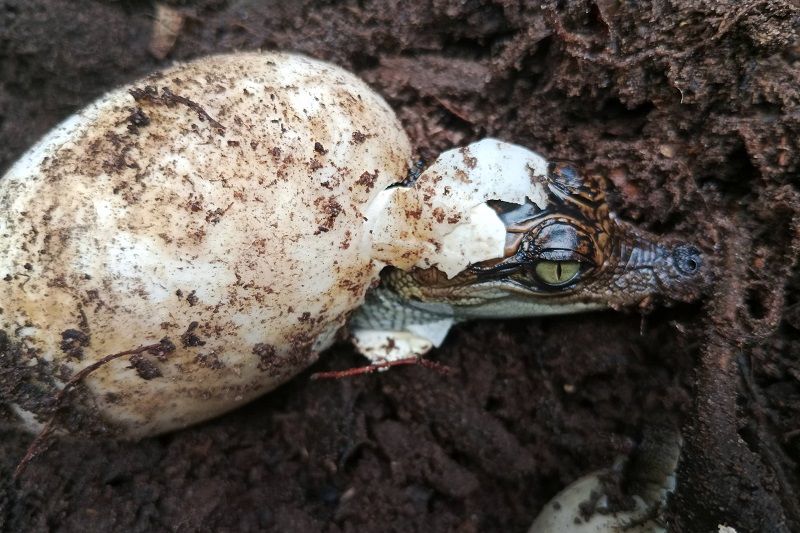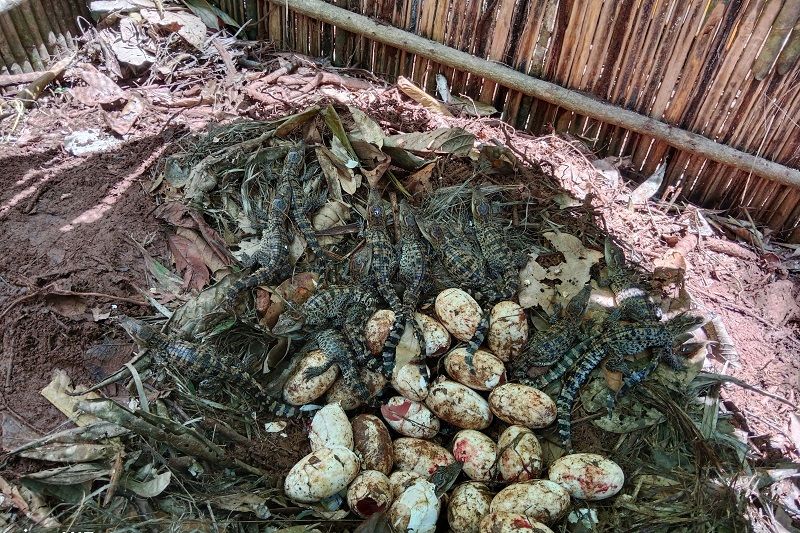PTES staff were thrilled about the exciting news that one of the rarest reptiles in the world has had a boost in numbers, thanks to the impressive efforts of PTES partner, Fauna & Flora. Read on for an inspiring report from their team and local experts about the discovery of Critically Endangered Siamese crocodile nests in the wild.
Escaping the jaws of extinction
Sixty Siamese crocodiles, from five separate nests, have successfully hatched in Cambodia’s Cardamom National Park – the largest record of this species breeding in the wild this century and a massive boost for the survival prospects of this critically endangered reptile.
Crocodiles tend to be given a bad press. But that notoriety does at least bring these much-maligned and misunderstood animals into the public consciousness. From alligators in the Everglades to Australia’s saltwater crocs and the wildebeest-grabbing Nile crocs, stories abound of narrow escapes from man-eating monsters.
Spare a thought for the Siamese crocodile. This little-known, unheralded reptile is neither monstrous nor man-eating. And in this case, the only noteworthy narrow escape has been on the part of the crocodile itself, from the jaws of extinction.
Once widespread in the wetlands of Southeast Asia, it has disappeared from 99% of its former range. The Siamese crocodile was feared to be extinct in the wild until a Fauna & Flora-led survey team rediscovered it in Cambodia’s Cardamom Mountains.
Community-led conservation of Siamese crocodiles
It’s no accident that the Siamese crocodiles in this remote region escaped the fate of so many of their kind. The local Indigenous People revere this reptile, and it is taboo to kill or hurt one. Unfortunately, the Siamese crocodile hasn’t always been afforded that level of care in the wider world. Decades of hunting and habitat loss decimated the wild populations. It is one of the world’s rarest reptiles and remains in urgent need of conservation attention.
The people who have always lived harmoniously alongside Siamese crocs are the ones best placed to protect them. For well over two decades, Fauna & Flora has worked closely with these local communities and the Cambodian government to safeguard – and supplement – the remaining crocodile population.
Community-led monitoring and anti-poaching activities are helping to protect key breeding sites, and we’re working with the Cambodian government to bolster the surviving wild crocodile population through a conservation-breeding and reintroduction programme. Since 2012, the programme has successfully released a total of 196 captive-bred Siamese crocodiles in safe areas and suitable habitats in the Cardamom Mountains.
And now we have further proof that our joint efforts are having a real impact on a species that was once in grave danger of sliding unnoticed into extinction.
Eggs in five baskets
In May 2024, a group of people living locally to the Cardamom Mountains discovered three nests in an area where captive-bred crocodiles have never been released before – suggesting that this is a key natural habitat for the species and that long-term protection efforts are allowing these wild populations to start bouncing back.
The local crocodile discoverers immediately reported the nests to Fauna & Flora’s Cambodian conservation team and the local community wardens, who mobilised to ensure the nests were protected around the clock. Just days later excitement heightened as two further nests were found in another area of Cardamom National Park.
At the end of June, a total of 60 Siamese crocodile hatchlings successfully emerged from these nests, an incredible result for conservationists and a real sign of hope for the future of this species.
Conserving crocs collaboratively
Pablo Sinovas, Country Director, Fauna & Flora Cambodia Programme, comments: “For over a decade, Fauna & Flora, alongside our dedicated partners including PTES, has been steadfast in our mission to bolster Siamese crocodile populations in Cambodia’s Cardamom Mountains. This involves not only breeding them in captivity but also ensuring they have a suitable habitat to be released into. Strengthening protection of key sites within Cardamom National Park is crucial, shielding these habitats from threats such as deforestation and poaching.
“The recent discovery of wild nests emphasises the vital importance of safeguarding this area. With only a few hundred individuals estimated in the wild, the hatching of 60 new crocodiles is a tremendous boost. At a time when wetland biodiversity is declining rapidly across the region, it underscores the potential for natural recovery through sustained collaborative conservation efforts.”
PTES is supporting Fauna & Flora with your generous donations. Working closely with local teams on the ground, the ultimate goal is to establish 10,000 Siamese crocodiles across multiple sanctuaries in the Cardamom Mountains and other reserves across Cambodia. Find out more about how your support is helping to protect the future of Critically Endangered Siamese crocodiles.
Header image credit Jeremy Holden, Fauna & Flora.


